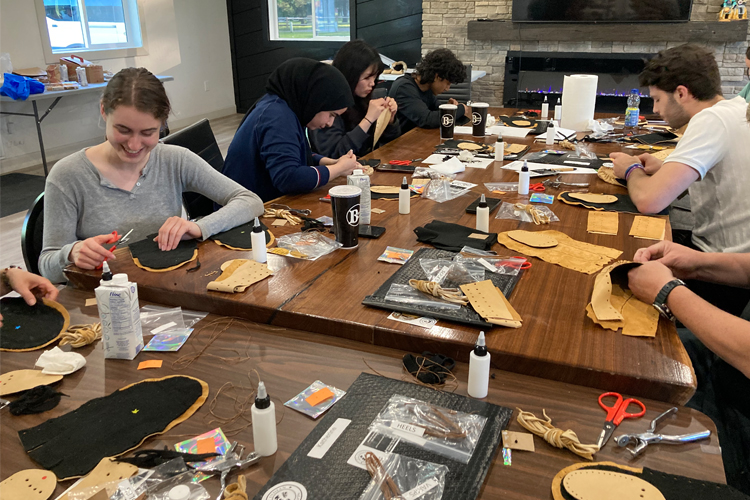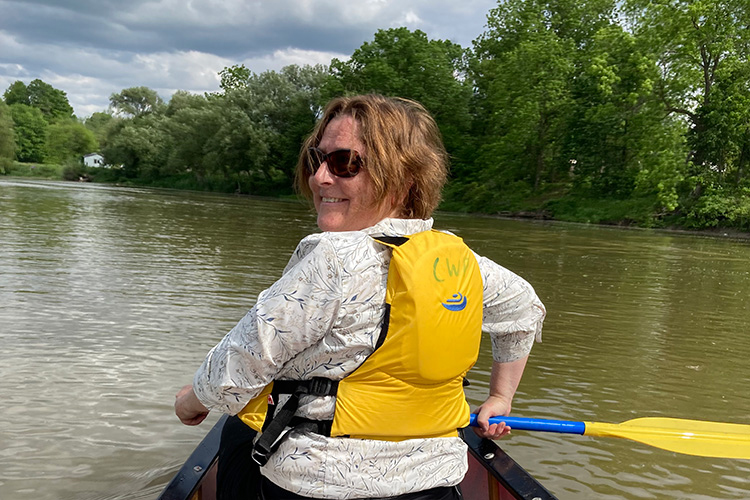As a member of the Mississaugas of the Credit First Nation, Tristen White has long been familiar with the concept of holistic health.
“I used to live in a rural area, and it was hard for me to get to a hospital or see a family doctor,” he says. “We practiced holistic health by using plants from our gardens, growing our own food, and taking care of each other.”
To gain a deeper understanding of Indigenous health practices, the fourth-year Indigenous Studies major and member of Victoria College completed a human biology course this past summer designed for that very purpose.
Indigenous Holistic Health explores the value of treating the whole person — on not only a physical, but a mental, emotional and spiritual level. It also explores the ways in which culture, the arts, land-based healing, music and ceremony inform health and healing.
The course is taught by Melanie Jeffrey, an assistant professor at the Centre for Indigenous Studies. She says that Western and Indigenous health care models are in many ways complementary, and that “there’s something to be learned from both paradigms.”

“However, Western frameworks look at health as the absence of disease: it’s a deficit-based model. Whereas the Indigenous framework looks at overall wellbeing: that’s the biggest difference between the two.”
Each year, the highlight of the course is a three-day visit to the Six Nations of the Grand River, demographically the largest reserve in Canada. There, students engage with a wide variety of activities: visiting treatment centres, going on medicine walks, learning about the importance of nutrition, and improving physical and mental health through activities such as storytelling, canoeing and making moccasins.
Lily Nosratabadi will soon graduate as a member of Innis College with a double major in human biology and environmental health and a minor in environmental studies. “I loved visiting Six Nations,” she says.
Nosratabadi especially enjoyed learning from the course’s array of Indigenous guest speakers and visiting different facilities at Six Nations. “One of the places we visited was a nursing home; watching the one-on-one interaction between a nurse and patient was so personal and moving. You can see how people are truly cared for from the beginning to the end of life,” she says.
Six Nations is home to the only Indigenous midwifery program in Ontario; students also visited a birthing centre to learn about traditional midwifery teachings.
“We visit with the frame of mind that Six Nations is a community partner,” says Jeffrey. “The role students have is to be listeners, and to take their new knowledge forward into their own lives. It comes from a place of humility and learning across cultures.”
Jeffrey cites the invaluable work of Meagan Kakwiráyentha Hamilton, managing director of U of T’s Indigenous Research Network, who serves as tutorial assistant for the summer course. “She’s a member of the Six Nations community, and I couldn’t do this without her — because of her insights into the community, and her knowledge of places where students can learn.”

Indigenous Holistic Health places a strong emphasis on land-based healing. To this end, students visit the Kayanase greenhouse, which provides services in plant restoration and species management. They also learn how tree rings are used as a metaphor for resilience and healing from trauma.
And although Tristen White was already familiar with many of the concepts discussed, he was grateful for the chance to absorb a broad variety of views. Before the visit to Six Nations, “we had an Inuit speaker who connected with us via Zoom,” he says of Muckpaloo Ipeelie. “I’m always interested to hear from other Indigenous communities. She told us about creation stories and plant medicines, and we got the chance to experience a totally different perspective.”
The course also provides instruction about cultural safety as it pertains to the Western medical system. One example is Jordan’s Principle, named for Jordan River Anderson — a child with multiple disabilities from Norway House Cree Nation in Manitoba, who died in hospital amid fighting between the provincial and federal governments over who would pay for his care.
The lessons imparted in this course serve not only to let students know about holistic health as it is practiced in Six Nations and elsewhere, but to apply those lessons in health care more generally.
As a researcher of English, Irish and Scottish heritage, Jeffrey lives this principle. While completing her PhD in toxicology, she came across the story of Grassy Narrows First Nation, a reserve in northwestern Ontario that has long been afflicted by mercury poisoning from a nearby pulp and paper mill. She began extensive research, but did not want to publish her findings.
“I knew it would be unethical to publish anything without having meaningful contact with the people of Grassy Narrows,” she says. “But when a different First Nations community reached out to me about how to get a cancer study going, I knew that I was ready in both an emotional and scholarly way. I had the science behind me and I was ready to listen deeply.”

Apart from cultivating a more expansive definition of health, Indigenous Holistic Health also advocates for a general culture of respect and partnership in health care.
“The students here are going to be the next generation of practitioners. They’re going to interact with Indigenous people who’ve had a very bad experience with biomedical health and healing, and they can be part of what transforms it into something better,” Jeffrey says.
“They need to be prepared for the fact that the system is not fair, so they can be part of a generation of leaders championing change: change that is driven by Indigenous communities, instead of being imposed on them.”

